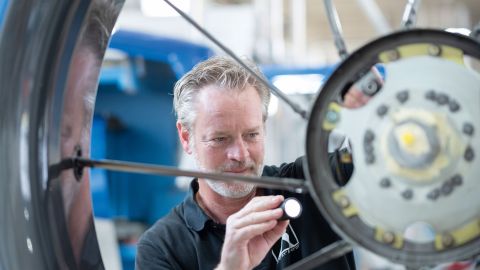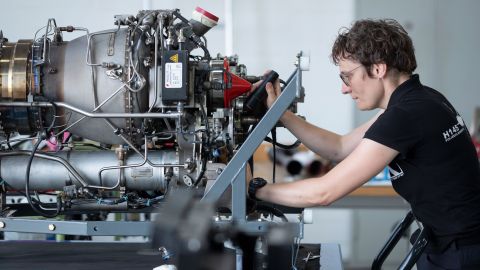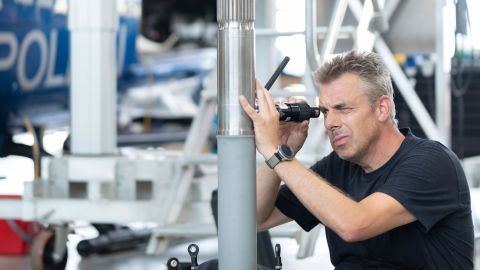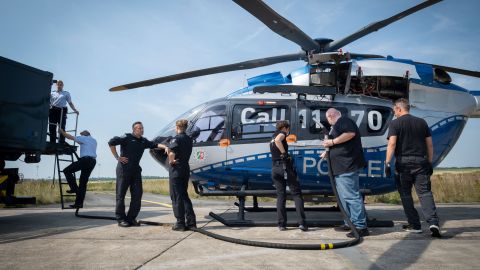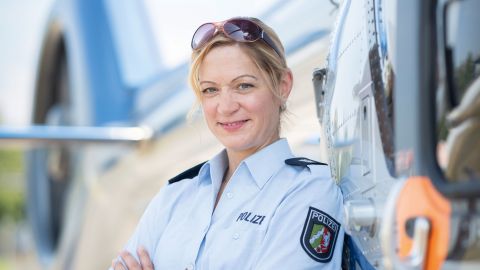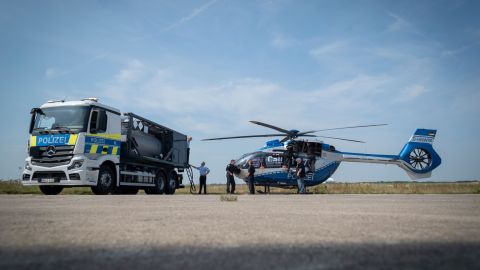Engines are being checked, test reports written and the tank container tested. A helicopter flies to the nearby Rhine to help a jet skier who has lost control of his vehicle. With its versatility and around 2,000 missions a year, the flying squadron ensures effective and efficient mission management for the NRW police.
The Airbus H145 is currently the most modern police helicopter available on the world market. Following the conversion from four to five rotor blades almost two years ago, unpleasant vibrations have been reduced. This was very important, as there were concerns that the vibrations could lead to health problems over a longer period of time. With the resulting increase in comfort, the crews can now concentrate better on their tasks - searching for missing persons, tracking down criminals, supporting special units, rescuing people or fighting forest fires. Each crew consists of two pilots and one operator. A job with a lot of variety: exciting, thrilling and responsible. You might think that young police officers would be queuing up for these jobs in Düsseldorf and Dortmund. But the flying squadron has recruitment problems. Both pilots and operators are being sought.
Flying used to be a purely male domain. That is no longer the case. Angelique Wibbeler was on patrol duty for eight years. Then she found out that the flying squadron was looking for an operator. The amateur pilot applied - and was successful. The police superintendent has been in the cockpit since September 2023. She is based in Dortmund. She operates the thermal imaging camera when searching for a missing person at night. Or she uses the video camera to record large gatherings and traffic jams. During forest fires, she has to direct the helicopter and get on the skids herself. The aim is to find a good position. The extinguishing container hooked under the fuselage has to be tipped out in the right place at the touch of a button. The so-called "Bambi Bucket" has a capacity of 820 liters.
Angelique Wibbeler has not been a member of the flying crew for very long. But she has already had a number of lucky moments. She particularly remembers the mission in which she spotted a suicidal young woman from the air who had been reported missing. "A person in a red sweater was lying huddled and unconscious on a hill. We landed on an adjacent meadow and carried her to the nearest road, where she was treated by the ambulance and the emergency doctor."
Without the 30 or so employees of the Air Wing's Technical Operations department, the six helicopters at the Düsseldorf and Dortmund bases would not be able to take off safely. Marc Dietel, for example. The mechanic spent more than 30 years keeping large aircraft in good shape at Lufthansa. Until coronavirus came along and staff had to be cut. "A police officer friend of mine advised me to apply to the flying squadron." A good idea, he thinks today. The switch worked out two years ago. The 56-year-old from Düsseldorf is happy to have made the move to the police: "I'm all about clean, perfect work." That is possible here. You are respected and not constantly pushed. He likes the "small group" of colleagues and the Airbus H145. He now knows every mechanical connection and every screw. "Helicopters from the squadron often fly over my house in the south of the city. That gives me family feelings. Somehow everything fits together now," he says.
No wonder. The working atmosphere is right. And the fact that Dietel ended up at the air force somehow fell into place. Because he has always felt a connection with "helicopters". In his spare time, he assembles model helicopters. "It's been my hobby for a long time." These are not miniature toys that he puts together. "They're real machines that reach 1.65 meters."
Colleague Stephanie Bohr trained as an aircraft mechanic in the German Army. She then joined the federal police. Three years ago, she joined the flying squadron and completed an examiner training course. "I wanted to develop myself further." She enjoys taking on even more responsibility now. "We have to guarantee the reliability of the systems," she explains. Maintenance programs have to be adhered to and completed. Once parts have been repaired, the 45-year-old then checks whether the helicopter can be released again. "A counter-check is still required for important components." At least one technician is always on board during the mandatory test flights.
Aircraft, and helicopters in particular, cannot simply pull over and wait for the breakdown service in the event of a defect. They are regularly inspected thoroughly and checked for wear and tear. Components must be replaced before they wear out. Many critical systems are duplicated, such as the two engines. However, there are parts that must not fail under any circumstances. In extreme cases, the H145 would crash.
"Everything is becoming more complex," says David Horn (47), who used to maintain Tornados in the German Armed Forces. Like Stefanie Bohr, he is a mechanic and tester. He is currently sitting at his computer writing to the manufacturer. During an inspection, scratches were discovered on the titanium rotor mast to which the rotor is attached and which therefore keeps the entire helicopter in the air. "First we measure how deep the scratches are." The basic question with all components is always: repair or replace?
Disturbances must be avoided at all costs. The avionics engineers also guarantee this. During the complex conversion of the H145 from four to five rotor blades, they relocated cable harnesses and connections, installed a hydraulic pump and moved the emergency transmitter from the front to the rear. When it comes to connectivity, the aircraft electronics engineers get involved.
All processes are digitally controlled. IT specialist Sebastian Haps joined the troops in July 2022. He worked in industry for 17 years. He was tempted to join the police. "Maybe it's because of my family, which has a few police officers in it," he says. When the IT position was advertised, he seized the opportunity. He enjoys the close contact with technology. He integrates new ready-made software into the devices or programs it himself.
No one would get into a helicopter if they didn't know that the technology would work reliably. To ensure this, the authorities have strict requirements. The European Aviation Safety Agency (EASA) sets extremely high standards for certification in flight operations. "That's a good thing," says Thorsten Voß, Technical Director. "We can't afford to be careless, otherwise we endanger ourselves and others." Up to 50 percent of working time has to be invested in the necessary documentation, reports the First Chief Superintendent. The maintenance staff are highly trained and have a good command of English. Without this, it is no longer possible. Almost all technical documents are written in English.
"It takes many years before a helicopter can be repaired and then released for the next flight," explains the Bochum native. Every move and every module is recorded. "Over the entire service life of a helicopter, we can track which elements have been installed or removed and who has done what. The whole thing results in a huge data record. Several times a year, checks are carried out to ensure that all rules and regulations have been adhered to. "We can't say we'll do the next inspection later or we'll try something cheaper." The helicopters are expected to be in use for 20 years and must still fly as reliably as on the first day.
"Unfortunately, it's not easy to recruit staff for this specialized field," says Thorsten Voß. "The industry is very small and we are competing with large airlines that need to have their aircraft repaired. We put a lot of effort into replacing staff who leave and are happy when we are also advertised within the police force."
There is hardly any leeway when it comes to costs. Torsten Roxin, who has been with the company for three years, completed a commercial apprenticeship and then worked as a supervisor for freight forwarders, logistics companies and a Luxembourg airline. He supports Voss with calculations and works in accounting and procurement. Of course, the credo that safety is the top priority is not abandoned.
In the office, Diana Pinand holds the reins. The police superintendent takes care of purchases, contracts and property as well as correspondence. In her private life, she is a mechanic and repairs classic cars. She is also a fan of air shows, where historic military aircraft can be seen.
In addition to the flight operations team in the state capital, there is a second one in Dortmund. The two teams work very closely together. Everyone knows everyone here. There are over 90 employees in total, including around 40 pilots. They fly the H145 and handle the flight and police radio communications. Senior Operator Carsten Krämer is responsible for organizational matters. He conducts selection interviews and is involved in the initial operator training. "Candidates should definitely have a stable stomach and be free from giddiness," he says with a broad smile, describing a basic requirement of the job.
The North Rhine-Westphalian flight squadron employs twelve operators. "But we would like to have two more positions, which we would like to advertise and fill in the medium term," he states. The police chief superintendent has been with the squadron for 15 years. The demands have grown considerably during this time. "In addition to the familiar police tasks, we also want to be able to support rescue operations during flood disasters or when fighting forest fires." Although the police only have secondary responsibility for these incidents, the police flight squadron is the only flying unit in the country. In these cases, it therefore naturally helps to minimize the damage and danger to the population. "But we also do a lot of other things. For example, we can measure accident tracks from above with centimeter precision using a grid method," he explains. The reconnaissance work with the camera is still important, even if drones have already taken over a lot. "During state visits, we collect information from the air as to whether the buildings are safe." They also check to see if there are any illegal cannabis plantations. These flights then take place at night, when the police officers can spot the light sources in the illegal greenhouses from the air.
The flying squadron is also proud of its tanker, which can transport 6,000 liters of kerosene in a removable container. The helicopters normally refuel at an airport. However, in many operational situations, the airport is a long way away. So time is wasted if an H145 has to fly back there again and again to refuel. The truck can now be used to bring large quantities of fuel close to the danger zones. This shortens the time needed for refueling stops and reduces costs. The whole team is delighted. IT specialist Sebastian Haps, Diana Pinand from the business office and businessman Torsten Roxin also support the ground staff with the logistics and lend a hand.
"This shows our extraordinary spirit," emphasizes Head of Technology Voss, who is also a trained pilot. "Everyone here is prepared to do something out of the ordinary." The 22-year veteran of the squadron believes that some people still underestimate what this unusual police unit has to achieve. It takes much more in the background than just the helicopters and the pilots. "Unfortunately, flying is very expensive," says the 53-year-old. "But we save lives and protect the population."
The conversion of the helicopters at the turn of the year from 2022 to 2023 has given them another boost. "With five rotors, we now have significantly more power. That helps with forest fires." The payload has increased by 100 kilos. "With ten rounds of extinguishing water, that's a whole additional ton." The conversion was implemented very quickly, summarizes Voß. It doesn't work so smoothly everywhere.
Flat hierarchies have proven their worth at the air squadron. "The skills and performance of the employees are what count here, regardless of their rank," says Thorsten Voß.
